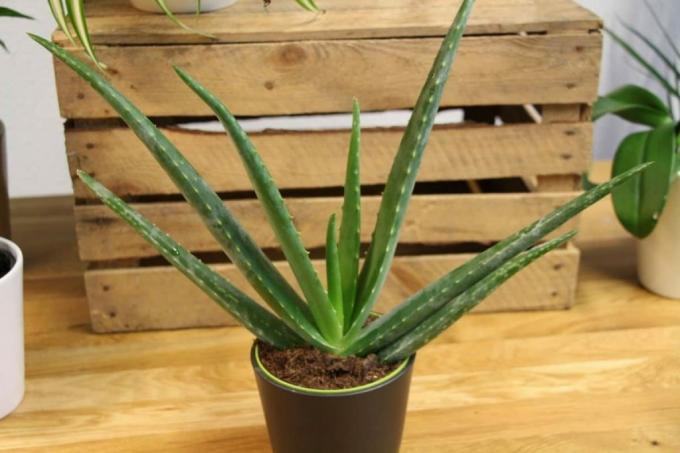
table of contents
- The healthy aloe vera
- Brown leaves due to incorrect care
- Irrigation failure
- rain
- Sun
- Lack of space
- Change of location
- Weather change
- Overfertilization
- Nutritional deficiency
- frequently asked Questions
the Aloe vera is popular as a houseplant. It is considered robust and easy to care for and is pretty to look at with its blue-green leaves. Why is it that the aloe vera leaves turn brown?
In a nutshell
- Aloe Vera is used as a medicinal and houseplant
- healthy plants have blue-green, pointed leaves with small thorns
- Brown discolorations indicate care errors or an incorrectly chosen location
- those who react quickly can often save the plant
The healthy aloe vera
The health of real aloe, as the tropical houseplant is also called, is shown by its blue-green, undamaged leaves. These have strong tips and small thorns on the edges. The growth is rosette-shaped. At the beginning of the year, a long-stemmed grape blossom forms in the center of the rosette. The yellow, orange or red tubular flowers appear in spring.

Note: The aloe vera blooms for the first time after three to four years.
Brown leaves due to incorrect care
In the following you will find out which care mistakes you can make with the aloe vera and how you can prevent the leaves from turning brown.
Irrigation failure
The robust houseplant and balcony plant requires little water. It belongs to the group of succulents and is able to store moisture in the pointed, thick-fleshed leaves.
Notes on pouring:
- Water only in the period from April to October when the soil is dry.
- Completely stop watering in autumn and winter.
- Pour only from below on the earth. - Do not wet the rosette with moisture.
- Spraying the plant is not necessary.

Signs of lack of moisture
A lack of moisture is indicated by the leaf tips turning red. This is the clue that you need to water the aloe vera more often.
Signs of too much moisture
Much more often than too little water, too much water is the reason for discoloration of the leaves. Brown leaves indicate too much moisture.
Tip: Stop watering for several days. Do not water again until the substrate is dry.
rain
Many plant lovers put their aloe on the balcony or in the garden. In this way, garden visitors can also enjoy the magnificent plant. When choosing a location, pay attention to protection from rain. Find a suitable place for potted plants, for example on the wall of the house, under an overhanging roof.
Be careful with planters! The trade offers a large number of decorative planters. However, these carry the risk of promoting waterlogging. You can prevent waterlogging with regular checks. If there is excess water in the pot, pour it off.

Tip: Fill the planter with potsherds. The drainage layer prevents waterlogging.
Sun
Although the robust plant can withstand heat waves, direct sunlight should be avoided. Otherwise burns can occur on the leaves. This sunburn leads to a hard, woody leaf surface. This protects the plant from damage inside the leaf.
Tip: Choose a protected location for balcony or outdoor plants.
Lack of space
Lack of space is one of the main causes of brown leaves. Repot the plant every two years. Choose a planter that leaves at least three centimeters of space around the root ball.
Tip: Add expanded clay or potsherds to the pot. Use cactus and succulent soil for planting.

Change of location
One of the causes of brown discoloration on the aloe leaves is a sudden change of location. Although the plant is very robust and easy to care for, it can only tolerate moving from inside to outside with caution.
Tip: After the winter quarters, slowly get the aloe used to the new environment. When the nights get colder in autumn, move the plant to a sheltered spot in good time.
Weather change
In the Central European regions, long dry periods are increasing in summer. The aloe in the field can usually tolerate this well. However, when thunderstorms and heavy rain occur afterwards, the dry, impermeable soil quickly causes waterlogging. The plant, which is heavily stressed by the change in weather, also reacts Putrefaction.
Not only the change from dryness to wetness, but also the change from hot to cold temperatures is a problem for the aloe.
Tip: Prevent waterlogging. Loosen the soil of the container and bedding plants in the event of long drought. Choose a protected location.

Overfertilization
The real aloe needs few nutrients. It thrives on poor substrate. When over-fertilized, the aloe leaves and tips turn brown. Prevent damage. Provide indoor and balcony plants with cactus fertilizer in spring.
Tip: If excessive accumulations of nutrients in the substrate lead to discoloration of the leaves, repot the plant. Provide them with fresh substrate. Refrain from fertilizing in the following weeks.
Nutritional deficiency
A lack of nutrients can also lead to growth damage in the robust aloe vera and cause the leaves and tips to turn brown. A lack of nutrients is shown by reduced growth, and the flowers also fail to appear.

Tip: Provide indoor and balcony plants with succulent fertilizer. Use it as described on the package insert.
frequently asked Questions
Take the aloe out of the pot. Remove the damaged aloe leaves and rotten roots with a clean knife. Let them sit on a kitchen towel for four days until the interfaces are dry. Plant the plant in new substrate. Water after a week at the earliest.
If you are using ordinary flower fertilizer, reduce the concentration to 25 percent of the stated amount. We recommend special fertilizers for cacti and succulents. This is tailored to the nutrient requirements of the plants.
Aloe Vera has been a medicinal plant that has been known for centuries. Its healing power is still used today for various human diseases. She herself is very rarely attacked by diseases.
What makes the aloe leaves glassy, soft and brown?
When succulent leaves become translucent, cold is often the cause. Aloe from Africa cannot tolerate temperatures below five degrees Celsius. Make sure to bring balcony plants to the winter quarters early in autumn.
